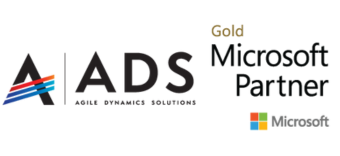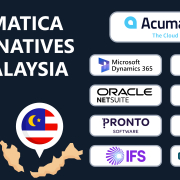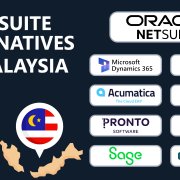Dynamics 365 Business Central vs SAP Business One in Malaysia: What are the Main Differences
Struggling to choose the right ERP solution for your business in Malaysia?
In this blog post, we will compare Dynamics 365 Business Central vs SAP Business One, discussing their features, pricing, and deployment options.
By understanding the main differences, you will be better equipped to make an informed decision that best fits your company’s needs.
Keep reading to learn more about these popular ERP solutions and their impact on your business operations.
TL: DR; Quick Overview
Do not want to read the entire article?
Here is a quick summary of each section of the article:
- Flexibility: Business Central offers greater flexibility with extensive customization options, seamless integration with other Microsoft products, and adaptability to unique business needs. SAP Business One, while flexible, has slightly more limited customization options and can present challenges when integrating with non-SAP software, making it less versatile when compared to Business Central.
- Customization: Business Central boasts extensive customization capabilities, easy-to-use development tools, and a wide range of add-ons, but excessive customization can lead to complexity and higher costs. SAP Business One, while customizable, offers fewer options compared to Business Central and may not be as comprehensive in terms of add-ons, making it less adaptable for unique business needs.
- Implementation: Business Central offers a flexible and scalable ERP solution with a smooth implementation process, requiring only the mandatory financial management module and one full user to start. However, partner quality may vary; thorough research on implementation partners is crucial. SAP Business One’s implementation can be more complex and time-consuming due to its architecture and the requirement to implement at least 10 modules. Its partner ecosystem is more tightly regulated, ensuring more consistent service quality.
- Pricing: Business Central offers a subscription-based, scalable pricing model with Essentials and Premium licensing options, making it cost-effective for smaller businesses starting with ERP systems. SAP Business One pricing is more complex, considering user count, modules, and deployment method, and while it can be more expensive upfront, it may be more cost-effective in the long run for certain businesses.
- Reporting: Business Central offers basic reporting with the option to integrate Power BI for advanced analytics, as well as industry-specific add-ons to enhance capabilities. SAP Business One provides comprehensive built-in analytics and reporting powered by SAP HANA, with additional customization through Crystal Reports, but has a steeper learning curve compared to Microsoft’s Power BI and Excel integration.
- Integrations: Business Central offers seamless integration capabilities, especially within the Microsoft ecosystem, allowing businesses to centralize operations and connect multiple systems. SAP Business One also has integration capabilities, but connecting with non-SAP software can be more challenging, often requiring customization or separate tools for each system.
- User Friendliness: Business Central has a familiar Microsoft 365 interface that is easy to adapt to and offers advanced capabilities, making it accessible for SMBs. SAP Business One, while feature-rich and powerful, has a steeper learning curve and a less intuitive interface, requiring more extensive training for users.
- Modules/Features: Business Central offers a comprehensive, scalable ERP solution with 14 modules, focusing on essential business processes. SAP Business One provides 15 and more advanced sets of modules and features, covering a broader range of processes and industry-specific requirements, but with a steeper learning curve and potentially higher implementation and maintenance costs.
- Deployment: Both Business Central and SAP Business One offer flexible deployment options, including cloud-based and on-premises solutions, catering to businesses with varying IT infrastructures and preferences. The choice between the two ERP systems will rely on other criteria, as their deployment options provide similar benefits.
- Ecosystem: Business Central’s ecosystem offers seamless integration with Microsoft products, a robust community of partners and developers, and a wide range of add-ons on AppSource, providing tailored solutions for users. SAP Business One has a strong ecosystem that includes other SAP products, but it is not as extensive as Microsoft’s, offering fewer resources and support options.
- Add-Ons: Business Central offers a growing marketplace of add-ons and extensions, developed by Microsoft partners and third-party developers, to customize and enhance the platform’s capabilities. SAP Business One also provides add-ons, but its options are not as extensive as Business Central’s. While the availability of add-ons is more limited, SAP B1’s wide range of built-in features means that add-ons are less often required.
- Platform Support: Business Central enjoys strong investment and support from Microsoft, which ensures continuous innovation, stability, and security. SAP Business One, while robust and comprehensive, may see less focus on innovation due to SAP’s primary investment in its flagship product, SAP S/4HANA. Businesses should consider each company’s strategic focus and long-term requirements when choosing between these solutions.
To get more information, scroll down to the respective section of the article. Also, check out SAP Business One alternatives.
Flexibility
Business Central
Microsoft Dynamics 365 core strength is its flexibility to customize, integrate and expand based on specific business needs. Dynamics 365 Business Central provides excellent customization options through its development environment, allowing businesses to adapt it to their unique requirements. Furthermore, Dynamics 365 Business Central offers seamless integration with other Microsoft products, such as Microsoft 365 and Power BI, which improves its flexibility in various business scenarios.
SAP Business One
SAP B1 is also a flexible ERP system in terms of customization and integration. However, the customization options are not as broad as those of Business Central. While SAP B1 integrates well with other SAP products such as SAP HANA and SAP Ariba, third-party integrations can be more challenging due to their proprietary nature. This might require additional resources, time, and expertise when trying to connect with non-SAP software or other custom applications. As a result, SAP Business One’s flexibility could be perceived as slightly limited when compared to Dynamics 365 Business Central, especially for businesses with diverse software ecosystems.
Customization
Business Central
Business Central offers robust customization capabilities and a framework that allows businesses to modify the system according to their unique business needs, industry-specific requirements, and business processes.
The customization process is made even easier by using Microsoft’s AL language and Visual Studio Code, which enables developers to create extensions and tailor the platform to their specific use cases.
Additionally, Business Central offers an extensive library of add-ons and extensions through its AppSource marketplace, providing further customization options.
However, this can be a good or bad thing. Because many businesses get bogged down with so many customization requirements. Too many customizations can lead to a complex system, longer implementation times, and increased maintenance costs. Businesses must balance flexibility and simplicity for an efficient ERP solution.
SAP Business One
SAP Business One is less customizable compared to Business Central even though it is provided by SAP, which is well known for being very customizable ERP software to meet even the most demanding and unique business needs.
Customizations in SAP Business One can be achieved using the SAP Business One Studio Suite which includes tools like the Screen Painter and User-Defined Objects (UDO) for adapting the platform to specific business requirements.
Additionally, SAP Business One does have a range of add-ons available, the overall number and variety might not be as comprehensive as those found in Business Central’s AppSource marketplace.
Implementation
Business Central
Business Central is a flexible ERP solution that can be implemented in cloud, hybrid, or on-premises and businesses need to only implement the mandatory financial management module and purchase only one full user (Essentials or Premium) to get started and then later on, businesses can easily add more users and modules as they business grows or there would like to move their businesses processes under one system.
Microsoft’s extensive partner network also provides access to experienced consultants and resources to ensure a smooth implementation. Additionally, the platform’s integration with other Microsoft products can further streamline the implementation process.
However, because Microsoft’s ecosystem of partners is less regulated compared to SAP’s, the quality of implementation services can vary significantly between partners. Therefore, it is essential to carefully research and select the right implementation partner to ensure the success of your ERP project.
Agile Dynamics Solutions (ADS) is a leading Microsoft partner in Malaysia and Cambodia with 300+ customers, 1,000s completed projects, a 100% success rate, and excellent expert customer service. To learn more about ADS, please contact us or request a free demo.
SAP Business One
SAP B1 process can be more complex and time-consuming, especially because SAP B1 requires at least 10 modules to be implemented. This makes SAP B1 implementation a long and expensive project undertaken by a company.
Additionally, SAP B1 architecture is more complex and rigider which further adds to the implementation challenges. Customization and integration with other systems may require more time and resources compared to Business Central, potentially prolonging the project timeline.
SAP does have a partner network around the world to support the implementation of the product, but it is not as extensive as Microsoft’s. This is because SAP’s partner ecosystem is more tightly regulated, which can lead to a more consistent level of quality in terms of implementation services.
Additional Resources:
Pricing
Business Central
Business Central pricing offers a subscription-based pricing model, which can be more cost-effective for small and medium-sized businesses. There are two main licensing options: Essentials and Premium. Essentials cover core financial management, supply chain, and basic CRM capabilities, while Premium adds service management and manufacturing functionalities.

The pricing is based on a per-user, per-month basis, making it scalable as the business grows. Additionally, businesses can choose between cloud, hybrid, or on-premises deployment, with different pricing structures for each.
Business Central is a cost-effective solution for businesses that want to start with an ERP system slowly and only implement financial management at first.
As said, to get started with Dynamics 365 Business Central you only need to implement the Business Central Financial Management as the core of the solution and later you can expand with additional modules such as Supply Chain Management, CRM, Inventory & Warehouse Management, Purchasing, Manufacturing, or others.
Also, businesses need to only subscribe to 1 full user (essentials or premium) to get started, making Business Central an affordable and versatile solution that helps businesses choose the best-of-breed solutions for their specific needs.
SAP Business One
SAP Business One pricing is generally more complex than Business Central’s, as it is based on a combination of factors, including the number of users, modules, and the deployment method (cloud or on-premises). SAP B1 offers a named user licensing model, with different tiers for professional, limited, and starter users, each with varying levels of access to the system’s features.
While SAP B1 can be more expensive upfront, especially with the required implementation of at least 10 modules, it may be more cost-effective in the long run for some businesses, depending on their size and specific needs.
Reporting
Business Central
Dynamics 365 Business Central provides basic out-of-the-box reporting to analyze your business data such as financial statements, sales performance, and inventory levels. However, to access more advanced reporting and analytics capabilities, businesses can leverage the integration with Power BI. Power BI offers interactive, real-time dashboards and reports, enabling users to gain deeper insights into various aspects of their business, such as customer behavior, supply chain efficiency, and workforce productivity
Moreover, Business Central’s extensible architecture allows for the integration of industry-specific add-ons, which can further enhance the system’s reporting capabilities. These add-ons, such as Jet Reports, provide tailored reporting solutions for various industries, making it easier for businesses to access and analyze the data most relevant to their unique needs.
This combination of out-of-the-box reporting, Power BI integration, and industry-specific add-ons make Business Central a versatile and powerful reporting solution for businesses of all sizes and industries.
SAP Business One
SAP Business One also provides a comprehensive suite of reporting tools and capabilities. It includes built-in analytics and reporting features, powered by the SAP HANA platform, which allows businesses to gain real-time insights and make data-driven decisions.
Additionally, SAP Business One supports the creation of custom reports through its Crystal Reports integration, providing more flexibility in terms of report design and formatting.
However, the learning curve for using SAP’s reporting tools can be steeper compared to Microsoft’s user-friendly Power BI and Excel integration, but SAP B1 provides better reporting capabilities out of the box.
Integrations
Business Central
Business Central offers open architecture and seamless integration capabilities allowing businesses to easily integrate their third-party systems and services. This helps businesses to centralize their operation without the need of replacing the entire IT ecosystem, streamline business processes and data, and get access to an advanced ERP system at an affordable price.
Also, as a part of the Microsoft ecosystem, Business Central integrates effortlessly with other Microsoft products such as Microsoft 365 (Word, Excel, SharePoint, Teams), Power Platform (Power BI, Power Automate, Power Apps, Power Virtual Agents), and Azure, providing a unified and cohesive solution for businesses.
This is arguably one of the biggest strengths of Dynamics 365 Business Central as in this way you can connect multiple systems into one and have the best-of-breed of business applications.
Additionally, Businesses can often get up and run quickly, with minimal disruption to their existing operations.
SAP Business One
SAP Business One has integration capabilities as well and businesses can easily integrate the system with other SAP products, such as SAP HANA and SAP Ariba. However, connecting with non-SAP software can be more challenging due to its nature.
Connecting SAP B1 with third-party software often requires customization or using separate tools for every system that you want to connect to.
However, integration of SAP B1 is less common than with Dynamics 365 Business Central because with SAP B1 businesses must implement at least 10 modules, meaning that most of the business operations will have to adopt the new system. Due to that, businesses require less integration.
User Friendliness
Business Central
Business Central has the familiar look and feel of Microsoft applications such as Microsoft 365 interface, which many businesses find attractive due to their existing experience and familiarity with Microsoft products. This allows businesses and users to easily adapt to the new system, reducing the learning curve, and increasing user adoption and productivity.

While Business Central provides a user-friendly interface, it still provides advanced capabilities and functions such as dashboard customization, advanced financial, reporting, sales, warehouse, and other capabilities, making it a powerful and accessible solution for SMBs (Small and Medium Businesses) and subsidiaries in Malaysia.
SAP Business One
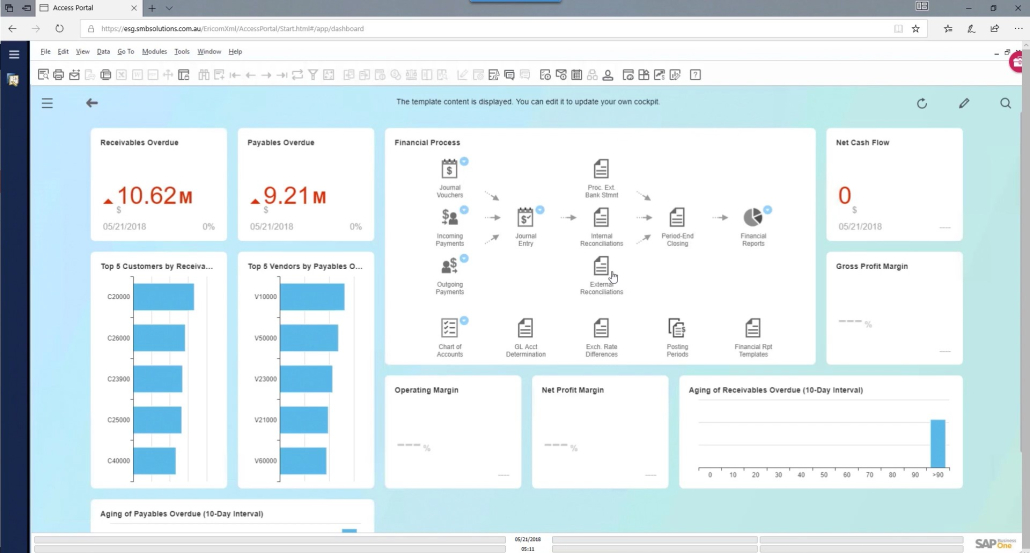
SAP Business One is considered less user-friendly due to its feature-rich, powerful, and advanced capabilities. Because of that SAP B1 has a steeper learning curve when compared to Business Central. Its interface is not as intuitive as Microsoft’s, and users may require more extensive training to become proficient with the system.
Modules/Features
Business Central
Business Central is a comprehensive ERP business management solution with a set of 14 modules and a wide range of features, covering all essential aspects of business processes such as financial management, supply chain management, customer relationship management, warehouse and inventory management, manufacturing, and project management.
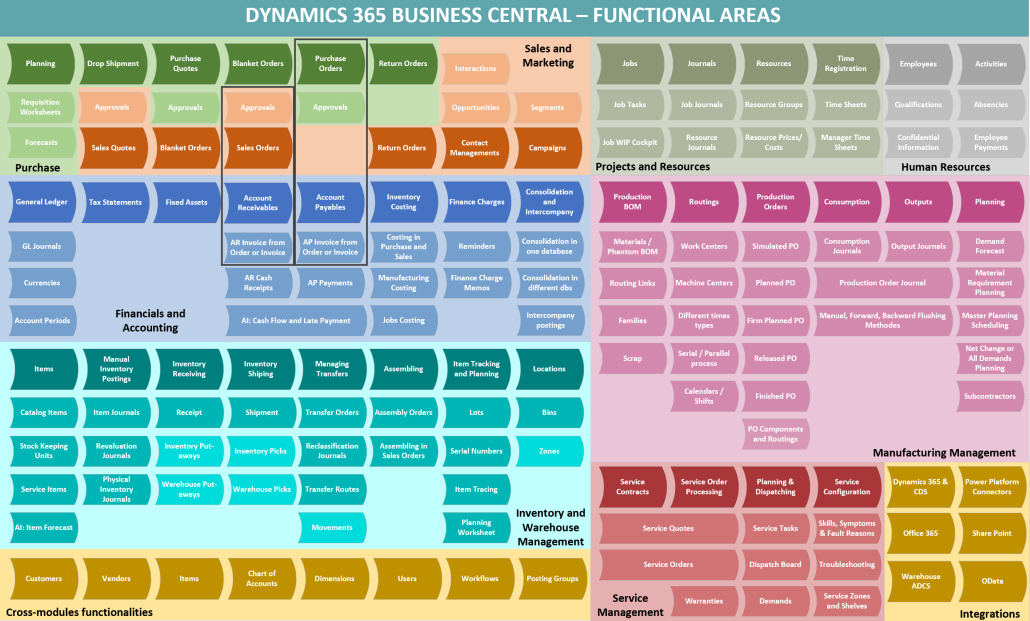
Business Central is a modular solution where under two pricing plans you get access to different modules and businesses can choose the features or modules they need for their users. As already mentioned, only the financial management module is mandatory and the rest can be added later, making it a scalable and adaptable solution.
SAP Business One
SAP Business One provides a more advanced set of modules and features, covering a broader range of business processes and industry-specific requirements. It offers more modules than Business Central, and within each module, there are more features available, providing a higher level of granularity and control.
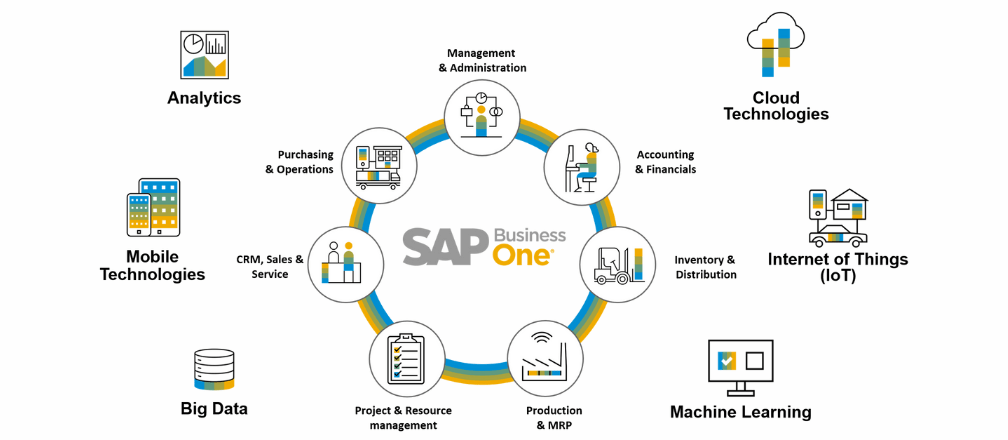
This makes SAP Business One a more powerful and comprehensive solution, particularly for businesses with complex needs or those operating in specialized industries.
However, the increased complexity and feature set may result in a steeper learning curve for users and higher implementation and maintenance costs.
Deployment
Business Central
Business Central offers flexible deployment options to suit the needs of different businesses and regulations. Business Central is developed as a native cloud-based ERP software which is an attractive option for businesses looking to implement ERP solutions in-cloud with lower cost, easy scalability, and minimal hardware requirements, as well as easy to update the software.
However, for organizations that require more control over their data or have specific regulatory requirements, Business Central also provides on-premises and hybrid deployment options.
This flexibility allows your business to deploy the solution that best aligns with your business goals, IT infrastructure, and budget. However, once you implement Business Central in the cloud it cannot be reversed into an on-premises solution.
SAP Business One
SAP Business One also offers multiple deployment options, including both cloud-based and on-premises solutions. The cloud-based option provides similar benefits to Business Central’s cloud offering, such as reduced hardware costs, easier scalability, and simplified maintenance.
For businesses that prefer to have more control over their data and IT infrastructure, SAP Business One’s on-premises deployment is available. However, the on-premises option may involve higher upfront costs and increased complexity in terms of hardware and infrastructure setup compared to the cloud-based alternative.
Overall, both solutions offer the same deployment options with similar benefits to each other. Therefore, when you are choosing which of these ERP systems is best for your needs, it will come down to other criteria.
Ecosystem
Business Central
Dynamics 365 Business Central benefits from being seamlessly integrated within the Microsoft ecosystem which includes native integrations with other Dynamics 365 applications such as Dynamics 365 Sales, Dynamics 365 Customer Service, or Dynamics 365 Field Service, as well as with Microsoft 365 applications (Word, Excel, SharePoint, Teams).

(Credit)
Also, Business Central is integrated into Power Platform with native options of using Microsoft Power BI or Power Automate in the system.
Lastly, all users benefit from using Microsoft ChatGPT technology integrated into Dynamics 365, Microsoft 365, and Power Platforms.
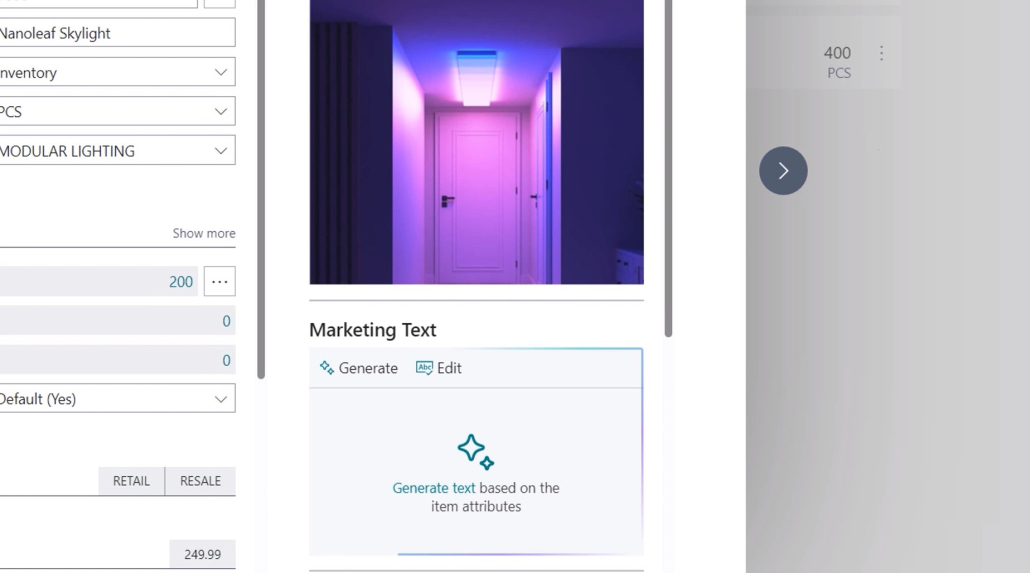
Besides Microsoft’s platforms, the robust community of partners and developers, who create hundreds of add-ons, customizations, and integrations available on AppSource to further enhance the platform’s capabilities enables them to customize and tailor Business Central.
This extensive ecosystem enables users of Dynamics 365 Business Central to tailor their solutions to their specific needs, requirements, and processes.
To learn more about Microsoft Copilot’s capabilities, check out Microsoft Dynamics 365 Copilot, Microsoft 365 Copilot, Microsoft Power App Copilot, and Microsoft Power Virtual Agents Copilot.
SAP Business One
SAP Business One also provides a strong ecosystem that includes other SAP products such as SAP S/4HANA, SAP Ariba, or SAP SuccessFactors. This allows companies to get access to a wide range of features and capabilities for a cohesive experience.
However, SAP’s ecosystem is not as extensive as Microsoft’s, but it still provides a range of resources, support, and innovations to help businesses make the most of their investment in the platform.
Add-Ons
Business Central
Dynamics 365 Business Central has an ever-growing marketplace of add-ons and extensions that users can purchase to customize their solutions for specific processes, needs, or requirements. These solutions are developed by Independent Software Distributors authorized by Microsoft, and they help greatly enhance the platform’s capabilities.
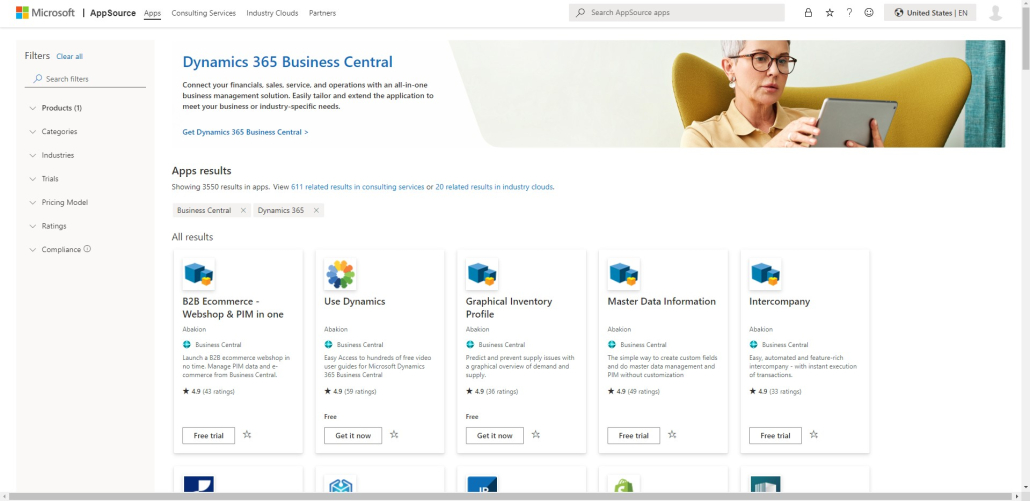
These add-ons developed by Microsoft partners and third-party developers cover a wide range of functionalities and industries, offering businesses the opportunity to customize and expand their ERP systems. From industry-specific modules to advanced reporting tools, the availability of add-ons makes Business Central a highly adaptable solution for a diverse range of organizations.
For example, Agile Dynamics Solutions provides Tax Localization for Malaysia and Reporting Localization for Malaysia for companies using Business Central in Malaysia.
SAP Business One
SAP Business One also offers a variety of add-ons to enhance the system capabilities and core functionality and cater to the specific needs of businesses across different industries.
These add-ons can be SAP itself, SAP partners, and third-party developers and cover areas such as advanced analytics, specialized industry solutions, and integrations with other applications.
Again, SAP B1 does not provide such extensive options of add-ons like Business Central, there are still plenty to choose from. Additionally, thanks to the wide range of available features within SAP Business One and the nature of the product, addons are less often required.
Platform Support
Business Central
Microsoft is highly committed to investing in Business Central with continuous innovation and support. Microsoft invests heavily in R&D, ensuring that Business Central stays up to date with the latest technological advancements and industry trends. This ensures that businesses using Business Central can rely on a stable, secure, and ever-evolving platform that will continue to adapt and grow alongside their organization’s needs.
SAP Business One
While SAP Business One is a robust and comprehensive ERP solution, it is worth noting that SAP invests a sizable portion of its R&D dollars in its flagship product, SAP S/4HANA. This could potentially impact the pace of innovation and long-term support for SAP Business One.
However, SAP remains committed to supporting and maintaining SAP Business One as a key offering within its product portfolio. Businesses considering SAP Business One should consider the company’s strategic focus on SAP S/4HANA and assess their long-term requirements to determine if this solution is the best fit for their organization.
Final Thoughts on Dynamics 365 Business Central vs SAP Business One
Dynamics 365 Business Central and SAP Business One are two very popular ERP systems used by small-medium size companies around the world and which one of these products is more suitable for your business depends on your business.
By using this comparison, and contacting respective ERP vendors for both systems, you can get a full picture of the system’s pros and cons.
There is no one-size fit system that will be better than the rest of the available solutions.
But there is no doubt about Microsoft has a bigger commitment to developing ERP business management software suitable for SMBs in Malaysia and around the world.
Discover the Benefits of Microsoft Dynamics 365 Business Central for Malaysian Businesses
Microsoft Dynamics 365 Business Central offers a powerful ERP solution that adapts to your unique business needs. Agile Dynamics Solutions, a leading Microsoft partner in Malaysia, helps businesses harness this versatile tool. With seamless Microsoft ecosystem integration and customized localizations for Malaysian taxation and reporting, Business Central empowers businesses to streamline operations and drive growth. Explore the advantages of this dynamic solution and how it can transform your organization.
Related Articles:
- 8 Best ERP for SMBs in Malaysia
- Enterprise Resource Planning (ERP) Basics
- Cost of Dynamics 365
- What is Business Central?
- Dynamics 365 Implementation Process
- ERP Modules
- How Can Be ERP Deploy?
- ERP Vendors in Malaysia
- Best Manufacturing ERP Systems in Malaysia
Dynamics 365 Business Central vs SAP Business One FAQs:
What is the difference between SAP and Business Central?
The main difference between SAP and Business Central is their target market and functionality. SAP is a software corporation offering a variety of ERP systems for different industries and business sizes. Business Central, on the other hand, is a specific ERP solution from Microsoft designed for small and medium-sized businesses. SAP’s solutions can be more complex and offer broader functionality, while Business Central focuses on user-friendliness, seamless integration with other Microsoft products, and affordability.
How do Dynamics 365 Business Central and SAP Business One compare in terms of pricing, licensing, and total cost of ownership?
Dynamics 365 Business Central offers a subscription-based pricing model with two plans, while SAP Business One has a more complex pricing structure involving licenses and maintenance fees. Business Central’s pricing is generally more transparent and predictable, while SAP Business One’s total cost of ownership can be higher due to additional costs such as customization and implementation services.
What are the disadvantages of SAP Business One?
SAP Business One disadvantages include high implementation costs, limited scalability, complex customization, steep learning curve, and dependency on SAP partners for support. Businesses may struggle with adapting to the system, leading to longer implementation periods and potential challenges in meeting unique requirements.
Is SAP Business One the same as SAP?
No, SAP Business One is not the same as SAP. SAP Business One is a specific ERP solution designed for small and medium-sized businesses, while SAP (Systems, Applications, and Products in Data Processing) is a multinational software corporation offering a wide range of enterprise software products, including various ERP systems tailored to different industries and business sizes.
